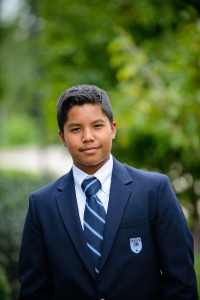Jessica Bai ’16, Francis Lee ’16: On February 23, 2016, the United States Patent and Trademark Office acknowledged Philip Persaud ’17 as an official U.S. Provisional Patent holder.
Persaud has been working on an artificial human meniscus since August of 2015 and finished his design in December. After winning the first award at the state level of the Pennsylvania Junior Academy of Science for biomedical engineering, he has since then branched out into the field of medicine.
He explains, “I initially needed a project for PJAS. I picked a biomedical engineering topic as I had success in engineering projects before and wanted to do something with medicine this year.”
Persaud was inspired by Bo Jackson, one of his sports heroes whose career ended due to a hip injury that caused the cartilage in his hip to deteriorate.
“I thought it would be interesting if I could find a way to prevent this injury from occurring in the first place,” elaborates Persaud, “I did some research and found an article on an artificial meniscus that used Kevlar and PCU, the materials I would eventually use, and found that, while it was effective, it could have been improved upon.”
After speaking with connections at the University of Pennsylvania, Persaud was motivated to improve the lives of those with implants and to change the medical industry.
“[My uncle] told me that the medical industry is extremely corrupt, implants are not made to last a while, and it is causing many people to suffer as they have to continue to go back every few years to get a new one,” recalls Persaud, “At that moment, I realized I had an opportunity, albeit an extremely small one, to revolutionize the medical industry by creating an implant that was designed to last longer and have better weight distribution properties than previous versions of it.”

Photo Courtesy of Mark Tassoni
His next course of action was to expand upon the previous research done by scientists at Duke and Columbia University to develop his project. After consulting several Episcopal teachers, Persaud was able to get his design ready for the competition, and states. ‘The idea and the design was validated by software that I used for conducting my experiment as a part of PJAS, which I won first award at regionals and am going to states for.”
He attributes much of his success to Dr. Kelley Bethoney, Upper School Science teacher and PJAS Coordinator at EA, and Mr. Stephen Kerwin, Upper School Science teacher.
Persaud expresses his gratitude, noting, “Dr. Bethoney was really helpful as she helped me refine my design by asking me key questions. She also was the one who encouraged me to file a patent in the first place. In addition, Mr. Kerwin was really helpful in answering numerous questions that I had for him in regard to optimizing weight distribution.”
Bethoney, who has mentored Persaud for the past two years in PJAS, says, “His project from last year exceeded my expectations in both complexity and rigor. This year, Philip has continued to delve into, and explore his interest in, science and medicine by focusing on the human knee. While his work is in its initial stages, I am very excited to see where he takes his ideas and designs, as many could potentially benefit from his work going forward.”
Persaud hopes to compete at the Intel International Science and Engineering Fair which is held in California next fall. His ultimate goal is to initiate a research company that addresses medical problems and improve upon their existing solutions.
Persaud concludes that he will “branch out and do different things for the community, as well as third world countries especially since my parents are both immigrants from underdeveloped countries. Although this is just the provisional patent, which only lasts a year, and is not reviewed, I will eventually file for a utility patent over the summer once I can build a prototype, which would then last for 20 years.”